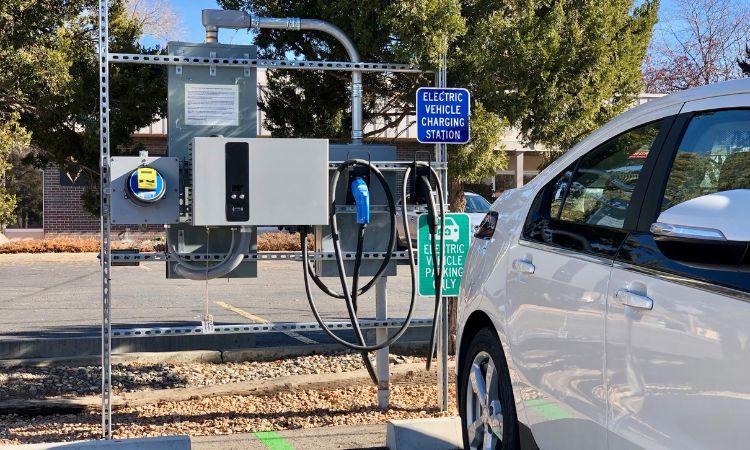The global electric vehicle charging station market size is assessed to grow in the forecast period of 2023-2028 at a CAGR of 30.20%. The market growth is being driven by increasing demand for electric vehicles and rising investments towards EV charging station infrastructure. As the world increasingly shifts towards sustainable transportation, electric vehicles (EVs) are becoming a mainstream choice for eco-conscious consumers. However, the adoption of electric vehicles is not solely dependent on the vehicles themselves but also on the availability and convenience of charging stations.
In this blog post, we will delve into the diverse world of EV charging stations. We will explore the different types of charging stations available today, from the basic Level 1 chargers to the cutting-edge wireless charging stations. Understanding these charging station types is essential for both EV owners and those looking to invest in charging infrastructure. So, let’s embark on this journey to discover the charging solutions that power the electric vehicles of tomorrow.
Level 1 Charging Stations
Definition and basic characteristics
Level 1 charging stations are the simplest form of EV charging infrastructure. They typically provide a standard 120-volt AC household outlet for charging an electric vehicle. This is the same outlet you might use to power your household appliances.
Low voltage and slow charging speed
The primary drawback of Level 1 chargers is their low voltage and, subsequently, slow charging speed. They are known for providing the slowest charging rate among all charging station types. This makes them less practical for EV owners who require quick recharges.
Suitable for home charging
Level 1 chargers are often used for home charging, where the vehicle is parked overnight or for an extended period. They are convenient for replenishing the battery while the car is not in use.
Pros and cons
-
Pros:
- Simple and cost-effective to install
- Suitable for overnight charging at home
- Compatible with standard household outlets
- No specialized equipment required
-
Cons:
- Slow charging speed (typically 2-5 miles of range per hour)
- Not practical for on-the-go charging or long trips
Level 2 Charging Stations
Explanation of Level 2 charging
Level 2 charging stations offer a significant step up in terms of charging speed compared to Level 1 chargers. These stations use a 240-volt power supply, which is similar to what is used for large appliances like electric stoves and clothes dryers.
Higher voltage and faster charging compared to Level 1
Level 2 chargers provide a charging rate that is several times faster than Level 1, typically delivering between 10 to 60 miles of range per hour, depending on the EV’s battery capacity and the charger’s power output.
Commonly found in residential, workplace, and public charging stations
Level 2 charging stations are versatile and can be found in various settings, including residential garages, workplace parking lots, and public charging networks. They strike a balance between convenience and charging speed.
Benefits for EV owners
EV owners benefit from Level 2 charging stations due to their reasonable charging speed and broader availability. These stations are well-suited for daily commuting and extended errands, allowing EVs to be charged relatively quickly during the day.
Installation requirements
Installing Level 2 charging stations may require professional electrical work to set up the 240-volt supply. Homeowners may need to make modifications to their electrical systems to accommodate Level 2 chargers. In workplaces and public locations, professional installation is standard.
DC Fast Charging Stations
Definition and key features
DC fast charging stations, also known as Level 3 chargers, offer rapid charging for electric vehicles. These stations use direct current (DC) to charge the vehicle’s battery directly, bypassing the vehicle’s onboard charger. This significantly reduces charging times.
Rapid charging for long trips
DC fast charging is crucial for long-distance travel and reduces charging times from hours to minutes. It is designed to provide a quick boost to an EV’s battery, allowing drivers to continue their journeys without lengthy stops.
Types of DC fast chargers (e.g., CHAdeMO, CCS, Tesla Superchargers)
There are different types of DC fast charging connectors and standards, including CHAdeMO, CCS (Combo Charging System), and Tesla Superchargers. These standards vary by manufacturer and are not always compatible with all EVs, so it’s essential for EV owners to check compatibility before using them.
Availability and locations
DC fast charging stations are commonly found along highways, major travel routes, and in urban areas. They are strategically located to support long-distance travel and reduce range anxiety for EV owners.
Pros and cons
-
Pros:
- Ultra-fast charging speeds (can provide up to 250 miles of range in 30 minutes)
- Ideal for long trips and reducing charging stops
- Strategic placement along highways and travel routes
-
Cons:
- Limited compatibility with some EV models
- Higher installation and operating costs compared to Level 1 and Level 2 chargers
Wireless Charging Stations
Introduction to wireless EV charging
Wireless EV charging stations represent the future of EV charging technology. They eliminate the need for physical cables and connectors by using electromagnetic fields to transfer energy from the charging station to the vehicle.
Inductive vs. resonant wireless charging
Wireless charging can be divided into two primary categories: inductive and resonant. Inductive charging uses electromagnetic fields to transfer energy between two coils—one in the charging station and one in the EV. Resonant charging operates on similar principles but with greater spatial flexibility, allowing for misalignment between the coils.
How wireless charging works
Wireless charging pads or plates are installed in parking spaces, and EVs equipped with compatible technology can simply park over these pads to begin charging. The technology offers the convenience of effortless and automatic charging.
Advantages and challenges
-
Advantages:
- Convenience and ease of use
- Reduction in wear and tear on physical charging connectors
- Potential for integration into parking infrastructure and autonomous charging
-
Challenges:
- Currently limited adoption and availability
- Efficiency concerns compared to wired charging
- Compatibility issues with existing EVs
Solar-Powered Charging Stations
Explanation of solar EV charging
Solar-powered EV charging stations combine renewable energy with EV infrastructure. They are designed to harness energy from the sun using photovoltaic panels and convert it into electricity for charging EVs.
Combining renewable energy with EV infrastructure
These stations are a sustainable solution, as they reduce the carbon footprint of EV charging by using clean energy. Excess energy generated during the day can be stored or fed back into the grid.
Benefits for sustainability
Solar-powered charging stations are environmentally friendly, as they reduce the reliance on fossil fuels for electricity generation. They contribute to the overall reduction of greenhouse gas emissions associated with EV charging.
Examples of solar charging projects
Various companies and organizations have invested in solar-powered EV charging projects. Highlighting specific examples and their impact on sustainability can illustrate the potential of this technology.
Networked Charging Stations
What are networked EV charging stations?
Networked EV charging stations are connected to the internet and communicate with a central management system. This connectivity enables various features and services that enhance the EV charging experience.
Advantages of networked stations
Networked stations offer several advantages, including real-time monitoring, remote updates, and user-friendly features like smartphone apps for locating, reserving, and paying for charging sessions.
Features like smartphone apps and payment systems
Discuss the convenience of smartphone apps that allow EV owners to find nearby charging stations, check availability, and initiate charging sessions. Additionally, networked stations often have integrated payment systems, making transactions seamless.
Popular charging networks
Highlight some of the popular EV charging networks that offer networked charging stations, emphasizing their coverage and benefits for EV owners.
Factors to Consider When Choosing a Charging Station
Range and battery size of your EV
Explain how the range and battery capacity of an EV impact the choice of charging station. Larger batteries may benefit from faster chargers, while shorter-range EVs may suffice with slower charging options.
Charging speed requirements
Discuss the importance of considering your daily driving habits and charging needs. Commuters with limited charging time may require faster chargers, while others can opt for slower options.
Access to different charging types
Highlight the importance of choosing a charging station that aligns with your EV’s capabilities. Some EVs are only compatible with specific charger types, so compatibility is essential.
Cost considerations
Discuss the costs associated with different charging station types, including installation, equipment, and electricity fees. Factors like government incentives and rebates can also impact the overall cost.
Location and convenience
Consider the convenience of charging locations, especially for home charging. Workplace and public charging station locations should also be convenient for your daily routines.



